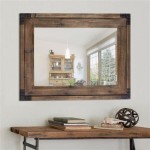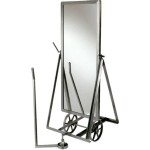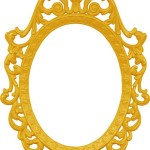Distressed Wood Mirrors: A Guide to Rustic Elegance
Distressed wood mirrors offer a unique blend of rustic charm and timeless elegance, making them a popular choice for various interior design styles. From farmhouse chic to coastal cottage, these mirrors can add character and depth to any room. This article explores the characteristics, creation process, design applications, and care considerations for distressed wood mirrors.
The appeal of distressed wood lies in its weathered appearance. This effect, achieved through various techniques, gives the wood a sense of history and authenticity. Marks, nicks, and imperfections become unique design elements, adding visual interest and texture. Distressed wood mirrors, therefore, offer a compelling alternative to pristine, polished surfaces, introducing a touch of the organic and imperfect into a space.
Several techniques contribute to creating the distressed look. Sandblasting can be used to erode the softer parts of the wood grain, creating a textured surface. Hand-planing or scraping with tools like drawknives or adzes adds deeper grooves and markings. Wire brushing removes softer fibers, highlighting the wood's natural grain. Chemical treatments, such as applying vinegar or ammonia, can create a weathered, grayed effect. Finally, applying layers of paint and then sanding them back reveals glimpses of the underlying colors, adding depth and complexity.
The type of wood significantly influences the final appearance of a distressed mirror. Pine, with its prominent knots and grains, readily takes on a rustic, farmhouse aesthetic. Oak, known for its durability and rich color, offers a more refined, aged appearance. Reclaimed wood, salvaged from old barns or structures, carries its own history and unique patina, lending an authentic, timeworn quality to the mirror.
The frame design plays a crucial role in the overall aesthetic. A simple, rectangular frame with subtle distressing can complement a minimalist or modern farmhouse style. Ornate, carved frames with heavier distressing create a statement piece suitable for traditional or eclectic interiors. The size and shape of the mirror itself also contribute to the overall design. Large, rectangular mirrors can create a sense of spaciousness, while smaller, round or oval mirrors offer a more decorative touch.
Distressed wood mirrors find applications in various interior design schemes. In a farmhouse setting, they can be paired with shiplap walls, wrought iron accents, and natural textiles. In a coastal cottage, they complement whitewashed furniture, nautical décor, and light, airy color palettes. Even in more contemporary settings, a distressed wood mirror can add a touch of warmth and character, contrasting with sleek lines and modern materials.
Placement of the distressed wood mirror significantly impacts its effect on the room. Positioning a large mirror opposite a window can amplify natural light and create an illusion of greater space. Hanging a smaller mirror above a console table or fireplace mantel creates a focal point and adds visual interest. Grouping several smaller mirrors together can create a gallery wall effect, showcasing a collection of styles and finishes.
Proper care and maintenance ensure the longevity and beauty of a distressed wood mirror. Dust regularly with a soft, dry cloth. Avoid using harsh chemicals or abrasive cleaners, as these can damage the finish. For spills or sticky residue, dampen a cloth with mild soap and water, wringing out excess moisture before gently wiping the affected area. Dry immediately with a clean cloth to prevent water damage. Avoid placing the mirror in direct sunlight or areas with high humidity, as these conditions can cause the wood to warp or the finish to fade.
When choosing a distressed wood mirror, consider the existing décor and desired aesthetic. The level of distressing, the type of wood, the frame design, and the size and shape of the mirror should all harmonize with the surrounding environment. By carefully considering these factors, one can select a distressed wood mirror that enhances the overall design and adds a touch of timeless, rustic elegance to any space.
Beyond aesthetics, the increasing popularity of distressed wood mirrors also reflects a growing appreciation for sustainable and eco-conscious design. The use of reclaimed wood minimizes the demand for newly harvested timber, contributing to forest conservation efforts. By repurposing and celebrating the beauty of aged materials, distressed wood mirrors offer a sustainable and stylish addition to any home.

Distressed Wood Frame Wall Mirror Kirklands Home

Distressed Wood Mirror 34 6 L X 16 5 W 1 2 D Wall Mirrors Set Of

White Distressed Wooden Mirror With Hooks Doris And Boris

Distressed Wood Mirror For Rustic Decor The Cabin S

Sophie Distressed Wood Mirror Holistic Habitat

Brogan Distressed Wood Slat Wall Mirror Multi Colored 43 X 26 By Aspire Com

John Lewis Distressed Wood Frame Wall Mirror Cream 102 X 72cm

Distressed Wood Framed Mirror Industrial Farm Co

Rustic Mirror Denali Antique White Heavily Distressed Wood

Herringbone Reclaimed Styled Wood Mirror Handmade In The Usa








